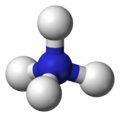Utente:Grasso Luigi/sanbox1/ammonio
Ione ammonio[modifica | modifica wikitesto]
| Ione ammonio | |
|---|---|
 | |
 | |
| Caratteristiche generali | |
| Massa molecolare (u) | 18,04 g/mol |
| Numero CAS | [Tool Labs] |
| Indicazioni di sicurezza | |


Il catione ammonio è uno ione poliatomico caricato positivamente, di formula chimica NH4+ dispari, massa molecolare 18,04 g/mol e numero CAS 6684-80-6[2], risultato di una protonazione dell'ammoniaca.
- NH3 + H+ → NH4+
In an unusual process, ammonium ions form an amalgam. Such species are prepared by the electrolysis of an ammonium solution using a mercury cathode.[3] This amalgam eventually decomposes to release ammonia and hydrogen.[4]
Biologia[modifica | modifica wikitesto]
Ammonium ions are a waste product of the metabolism of animals. In fish and aquatic invertebrates, it is excreted directly into the water. In mammals, sharks, and amphibians, it is converted in the urea cycle to urea, because urea is less toxic and can be stored more efficiently. In birds, reptiles, and terrestrial snails, metabolic ammonium is converted into uric acid, which is solid and can therefore be excreted with minimal water loss.[5]
Ammonium is an important source of nitrogen for many plant species, especially those growing on hypoxic soils. However, it is also toxic to most crop species and is rarely applied as a sole nitrogen source.[6]
Metalli di Ammonio[modifica | modifica wikitesto]
The ammonium ion has very similar properties to the heavier alkali metals and is often considered a close relative.[7][8][9] Ammonium is expected to behave as a metal (NH+4 ions in a sea of electrons) at very high pressures, such as inside gas giant planets such as Uranus and Neptune.[8][9]
Under normal conditions, ammonium does not exist as a pure metal, but does as an amalgam (alloy with mercury).[10]
Note[modifica | modifica wikitesto]
- ^ dioxidonitrogen(1+) (CHEBI:29424), in Chemical Entities of Biological Interest (ChEBI), European Bioinformatics Institute.
- ^ 6684-80-6, su tools.wmflabs.org, Wikimedia Tool Labs.
- ^ Pseudo-binary compounds
- ^ Ammonium Salts, in VIAS Encyclopedia.
- ^ Neil A. Campbell, 44, in Biology, 6th, San Francisco, Pearson Education, Inc, 2002, pp. 937–938, ISBN 0-8053-6624-5.
- ^ DT Britto, NH4+ toxicity in higher plants: a critical review (PDF), in Journal of Plant Physiology, vol. 159, n. 6, 2002, pp. 567–584, DOI:10.1078/0176-1617-0774.
- ^ (EN) A. F. Holleman E. Wiberg, Inorganic Chemistry, a cura di N. Wiberg, traduzione di M. Eagleson e W. Brewer, San Diego/Berlino, Academic Press/De Gruyter, 2001, ISBN 0-12-352651-5.
- ^ a b Does metallic ammonium exist?, in Nature, vol. 258, n. 5532, Nature Publishing Group, November 20, 1975, pp. 222–223, DOI:10.1038/258222a0. URL consultato il January 13, 2012.
- ^ a b Metallic Ammonium (PDF), in Monthly Notices of the Royal Astronomical Society, vol. 114, n. 2, Wiley-Blackwell for the Royal Astronomical Society, February 3, 1954, pp. 172–179, DOI:10.1093/mnras/114.2.172. URL consultato il January 13, 2012.
- ^ Lecture demonstration of ammonium amalgam, in Journal of Chemical Education, vol. 6, n. 10, October 1, 1929, p. 1767, DOI:10.1021/ed006p1767. URL consultato il October 28, 2015.